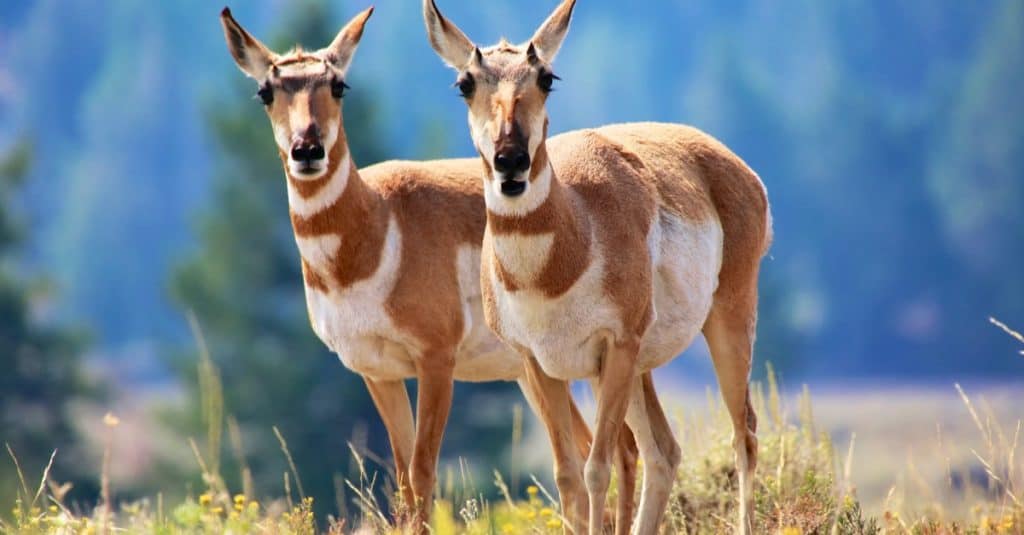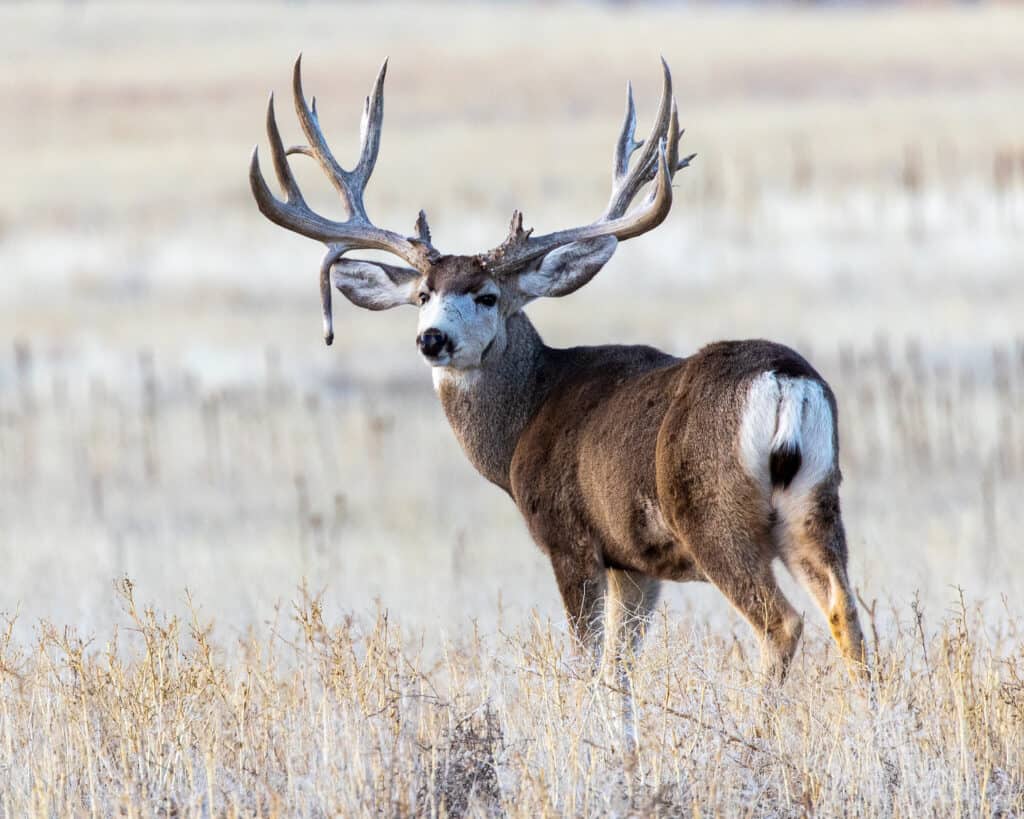Away from the Native American heritage, country music, oil and gas, college sports, and fried okra dish, Oklahoma is a biodiversity hotspot. Oklahoma has the most ecoregions per mile in the US. It is also one of four states with more than ten ecoregions. Forests cover 24% of the state, while its central and western regions are home to extensive ecosystems. Prairies? Wildlife preserves? Protected grasslands? All here in Oklahoma. From pronghorn to bald eagles and mountain lions, this state is a dream come true for wildlife and bird watchers. But just what are the fastest animals in Oklahoma? Let’s find out!
#1 Mexican Free-Tailed Bat – 99mph

The Mexican free-tailed bat (Tadarida brasiliensis) is a speedster of the skies and can reach up to 99 mph in flight – earning them the title of the fastest mammal on earth.
© – License
Mexican free-tailed bats are 3.5 to 4.25 inches long but are fast flyers. With a top speed of 99 mph in level flight, they can soar up to 10,000 feet in the air and consume tons of dangerous crop pests (specifically, two-thirds of their weight per night). Moths, leaf beetles, ants, wasps, and dragonflies are some insects often eaten by Mexican free-tailed bats. In a way, they protect crops and help farmers save costs.
The long, narrow-winged bats have large, rounded ears, wrinkled lips, and fur that ranges from dark brown to dark gray. They have a 1-1.5 inch long tail that extends the edge of the tail membrane. Although they can also be found in mines, tunnels, and bridges, Mexican free-tailed bats are primarily found in caves. Their maternity caves often have wide entrances, high ceilings (more than 25 feet), and a cozy atmosphere. In Oklahoma, two-thirds of the western region are home to this species, and the maternity caves can all be found in gypsum formations.
Mexican free-tailed bats have a stunning display of flights that attract people. However, you need a proper plan to ensure you don’t miss them. The bats are migratory; they spend the fall and winter in Mexico before flying back to the southern United States in the spring.
#2 Bald Eagle – 75mph

Bald eagles can achieve an incredible 75mph!
©Jack Molan/Shutterstock.com
With its white-feathered head and light yellow eyes, it’s easy to see why this species was chosen as America’s National Bird in 1782. The bald eagle (which isn’t actually bald) has big, hooked beaks and strong talons on its feet. It might interest you that female bald eagles have bigger sizes than males.
On the one hand, the larger females may sit on the nest for long periods. But, on the other hand, the smaller physiques of males make them somewhat better hunters. Bald eagles can grab prey from other birds and, occasionally, humans, thanks to their swiftness and razor-sharp claws. They can fly as fast as 75mph.
They can be migratory, depending on their habitat. For example, wild birds move to the south or the coast during the winter if their territory lacks access to open water because it prevents them from finding food. However, they stay all year if there’s open access to water.
Bald eagles spend their winters at larger reservoirs in Oklahoma, where they can be seen from October to April. The Great Salt Plains National Wildlife Refuge has the largest concentration of bald eagles. Grand Lake, Fort Gibson, Texoma, and Tenkiller Lakes are other places where a few bald eagles are seen.
#3 Pronghorn – 59mph

Capable of reaching 59mph, pronghorns are the second fastest land mammal in the world
©matthieu Gallet/Shutterstock.com
Pronghorn isn’t your regular mammal. It is the lone member of the Antilocapridae family and belongs to neither goat nor antelope families. Pronghorns are native to North America and are not found elsewhere in the world. They are the only animals with branched horns that shed annually. Male horns are inwardly curled and resemble lyres, while those of females are usually short and straight. Pronghorns range from red to tannish brown, while the rump, belly, cheeks, chest, and insides of its legs are white.
Apart from the uniqueness of their origin, speed is another reason pronghorns are famous. They can run up to 59 mph, making them the second fastest land mamma in the world after cheetahs. Pronghorns use their legs, sharp vision, and sensitive noses to navigate their habitat and escape danger. Mountain lions and coyotes are two natural predators of young pronghorns, but the adults lack many natural predators.
The majority of its southern range consists of open plains and dry grasslands. Pronghorns leave their winter ranges up to 100 miles away for safety from extremely thick snow. Pronghorns are active day and night, switching between feeding and brief periods of sleep. They live in mixed herds during the winter and seperate herds of males and females during the summer. Oklahoma has thriving populations of pronghorns. Cimarron and Texas counties in the state have enough pronghorns to offer hunting opportunities to sportspeople.
#4 Coyote – 43 mph

As active, able hunters, coyotes can run at speeds of up to 43mph
©Mircea Costina/Shutterstock.com
Coyotes are North America’s most vocal mammal and one of its most adaptable species. You can also call them prairie wolves or American jackals. They are canines with short legs and narrow pointed muzzles. Their underparts are lighter in color than their upper parts, which are reddish, gray, or yellowish-brown tints with black streaks.
Coyotes run up to 43 mph while in pursuit and may jump over a distance of more than 13 feet. Depending on the available prey, they may hunt alone, in pairs, or as a family. As coyotes are essentially carnivores that enjoy fresh meat, most of their diet consists of mammals. However, they often eat insects, birds, and snakes.
Coyotes are more active at night than during the day since they are vocal animals. They make different sounds as the need arises. Howls are to signal their whereabouts; yips welcome new pack members, and short barks send alerts of looming danger. You can find them in mountain ranges, deserts, and plains in North America. But unfortunately, they are also a regular sight in suburbs and cities as people encroach further on their natural habitats. Throughout the year, licensed coyote hunting in Oklahoma has no bag limit.
#5 Elk – 40mph

Despite their large size, elk can run at 40mph!
©Cody Linde/Shutterstock.com
Elk are the second-largest antlered animal in North America, weighing between 700 and 1,000 pounds. While females lack antlers, males often have massive antlers that reach up to four feet in height. This can give the animal a total height of about nine feet. Typically, the growth of antlers starts in the spring and sheds in the winter. As a result, their coats thicken as winter approaches to keep them warm against the cold. The habitat and season of the year have an impact on the color of their fur. As a result, it is reddish in the summer and pale grey in the winter. However, despite their large size, elk can run at 40mph.
Elk do not migrate in Oklahoma but make long seasonal migrations between their summer and winter ranges in some other regions. Take a trip to the Wichita Mountains National Wildlife Refuge, and you will almost certainly find a herd of elk. Other places to check in Oklahoma include the Spavinaw, Cookson Hills, Cherokee, and Pushmataha wildlife management areas. In addition, there are smaller herds on private lands in Comanche, Caddo, and Kiowa counties.
#6 Mule Deer – 40mph

Mule deer are easily recognized by their large ears.
©iStock.com/Jeff Edwards
This easily recognized deer species got its name from its oversized ears like those of a mule. Mule deer are indigenous to western North America and are one of its most cherished animals. They take on a tannish-brown color in summer and change to a brownish-gray hue in the winter. Their rump has a white patch, and their short, white tail has a black tip.
Mule deer bounce up and down like they are on springs because they use all four legs to strike downward and backward while propelling themselves upwards with each leap. They lives on rocky hills, so landing on all fours is a safer option than galloping. As a result, they can run at a top speed of 40mph.
Many Okies may not know this, but mule deer are common in the western region and inhabit the Oklahoma Panhandle. Mule and white-tailed deer don’t share the same range, despite being closely related. As a result, you can only spot mule deer in the extreme western parts of the state, active at night and in the early hours of the day. They migrate from low-elevation winter ranges to high-elevation summer ranges. However, the move is preceded by cold temperatures, violent snowstorms, and thick snow, which disrupt movement and food availability.
Up Next
The photo featured at the top of this post is © Charles Lemar Brown/Shutterstock.com
Sources
- Wildlife Department, Available here: https://www.wildlifedepartment.com/wildlife/field-guide/mammals/
- Travel OK, Available here: https://www.travelok.com/articles/oklahomasdiverseecoregions
- Hey Explorer, Available here: https://heyexplorer.com/what-is-oklahoma-known-and-famous-for/
Thank you for reading! Have some feedback for us? Contact the AZ Animals editorial team.






